ACC 4291 Semester 2: Tesla's Case Analysis - Production and Finance
VerifiedAdded on 2023/06/20
|34
|9670
|89
Case Study
AI Summary
This case study examines Tesla's journey in the automotive industry, focusing on its electric vehicle production and energy storage systems. It highlights Tesla's mission to accelerate the transition to sustainable energy and its strategic approach to manufacturing and distribution. The analysis identifies key issues such as production bottlenecks, financial instability, and competition from established automakers. The report explores alternative production models, including collaborative robots, and employs analytical tools like Fishbone Analysis and Critical Success Factors to evaluate these alternatives. Ultimately, it provides recommendations for Tesla to enhance production efficiency, improve financial stability, and strengthen its competitive position in the electric vehicle market. Desklib offers a range of similar case studies and solved assignments for students.
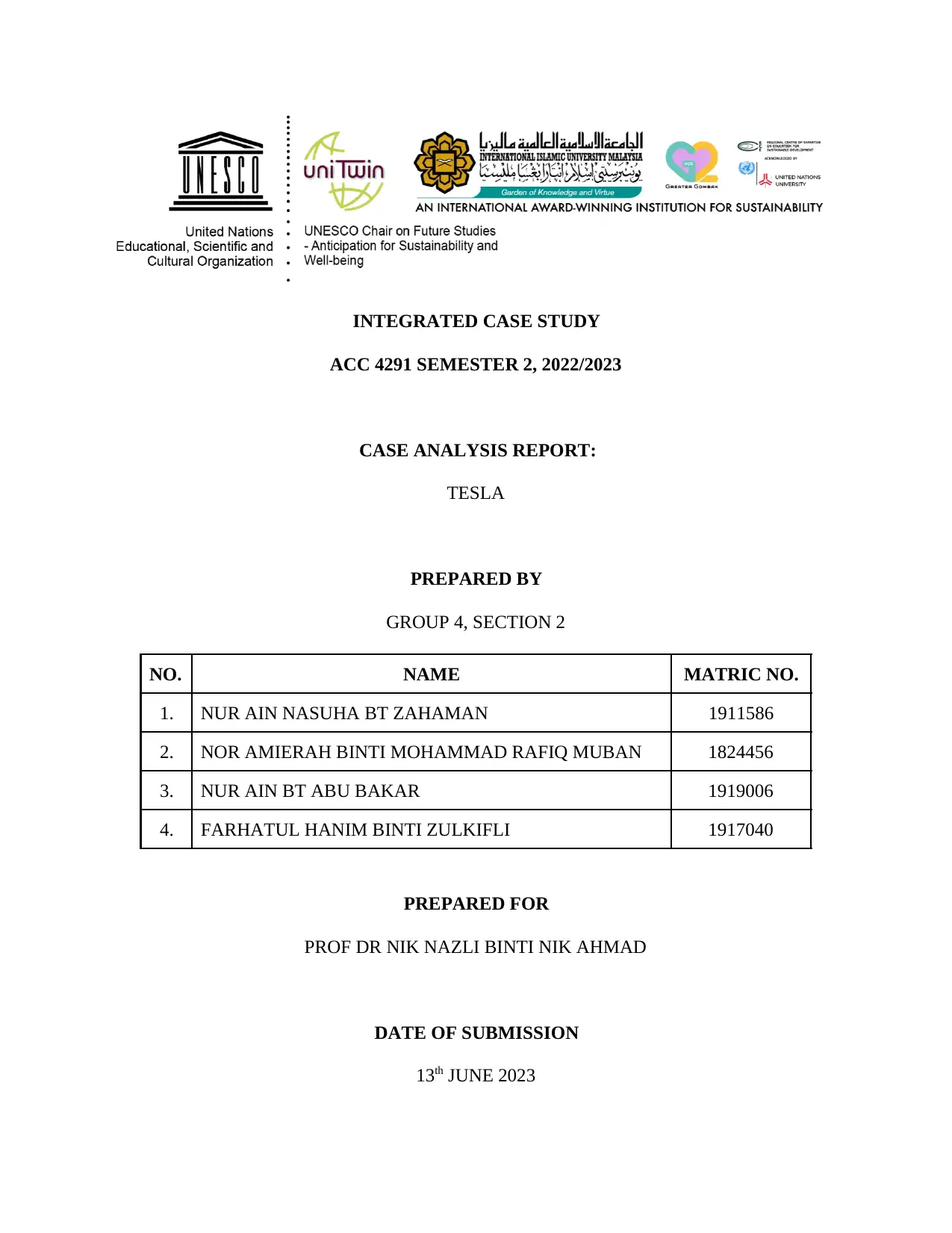
INTEGRATED CASE STUDY
ACC 4291 SEMESTER 2, 2022/2023
CASE ANALYSIS REPORT:
TESLA
PREPARED BY
GROUP 4, SECTION 2
NO. NAME MATRIC NO.
1. NUR AIN NASUHA BT ZAHAMAN 1911586
2. NOR AMIERAH BINTI MOHAMMAD RAFIQ MUBAN 1824456
3. NUR AIN BT ABU BAKAR 1919006
4. FARHATUL HANIM BINTI ZULKIFLI 1917040
PREPARED FOR
PROF DR NIK NAZLI BINTI NIK AHMAD
DATE OF SUBMISSION
13th JUNE 2023
ACC 4291 SEMESTER 2, 2022/2023
CASE ANALYSIS REPORT:
TESLA
PREPARED BY
GROUP 4, SECTION 2
NO. NAME MATRIC NO.
1. NUR AIN NASUHA BT ZAHAMAN 1911586
2. NOR AMIERAH BINTI MOHAMMAD RAFIQ MUBAN 1824456
3. NUR AIN BT ABU BAKAR 1919006
4. FARHATUL HANIM BINTI ZULKIFLI 1917040
PREPARED FOR
PROF DR NIK NAZLI BINTI NIK AHMAD
DATE OF SUBMISSION
13th JUNE 2023
Paraphrase This Document
Need a fresh take? Get an instant paraphrase of this document with our AI Paraphraser
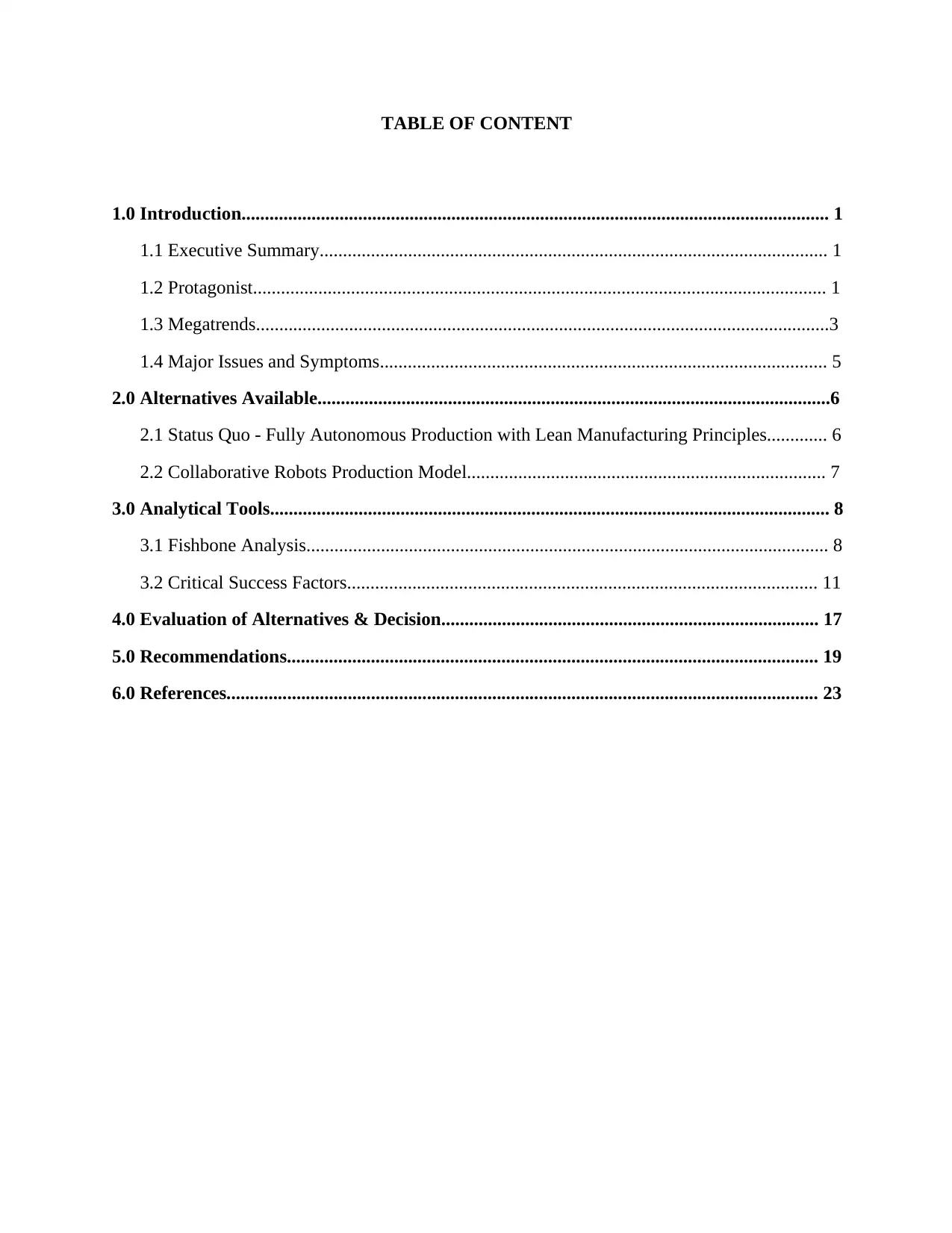
TABLE OF CONTENT
1.0 Introduction.............................................................................................................................. 1
1.1 Executive Summary............................................................................................................. 1
1.2 Protagonist........................................................................................................................... 1
1.3 Megatrends...........................................................................................................................3
1.4 Major Issues and Symptoms................................................................................................ 5
2.0 Alternatives Available..............................................................................................................6
2.1 Status Quo - Fully Autonomous Production with Lean Manufacturing Principles............. 6
2.2 Collaborative Robots Production Model............................................................................. 7
3.0 Analytical Tools........................................................................................................................ 8
3.1 Fishbone Analysis................................................................................................................ 8
3.2 Critical Success Factors..................................................................................................... 11
4.0 Evaluation of Alternatives & Decision................................................................................. 17
5.0 Recommendations.................................................................................................................. 19
6.0 References............................................................................................................................... 23
1.0 Introduction.............................................................................................................................. 1
1.1 Executive Summary............................................................................................................. 1
1.2 Protagonist........................................................................................................................... 1
1.3 Megatrends...........................................................................................................................3
1.4 Major Issues and Symptoms................................................................................................ 5
2.0 Alternatives Available..............................................................................................................6
2.1 Status Quo - Fully Autonomous Production with Lean Manufacturing Principles............. 6
2.2 Collaborative Robots Production Model............................................................................. 7
3.0 Analytical Tools........................................................................................................................ 8
3.1 Fishbone Analysis................................................................................................................ 8
3.2 Critical Success Factors..................................................................................................... 11
4.0 Evaluation of Alternatives & Decision................................................................................. 17
5.0 Recommendations.................................................................................................................. 19
6.0 References............................................................................................................................... 23
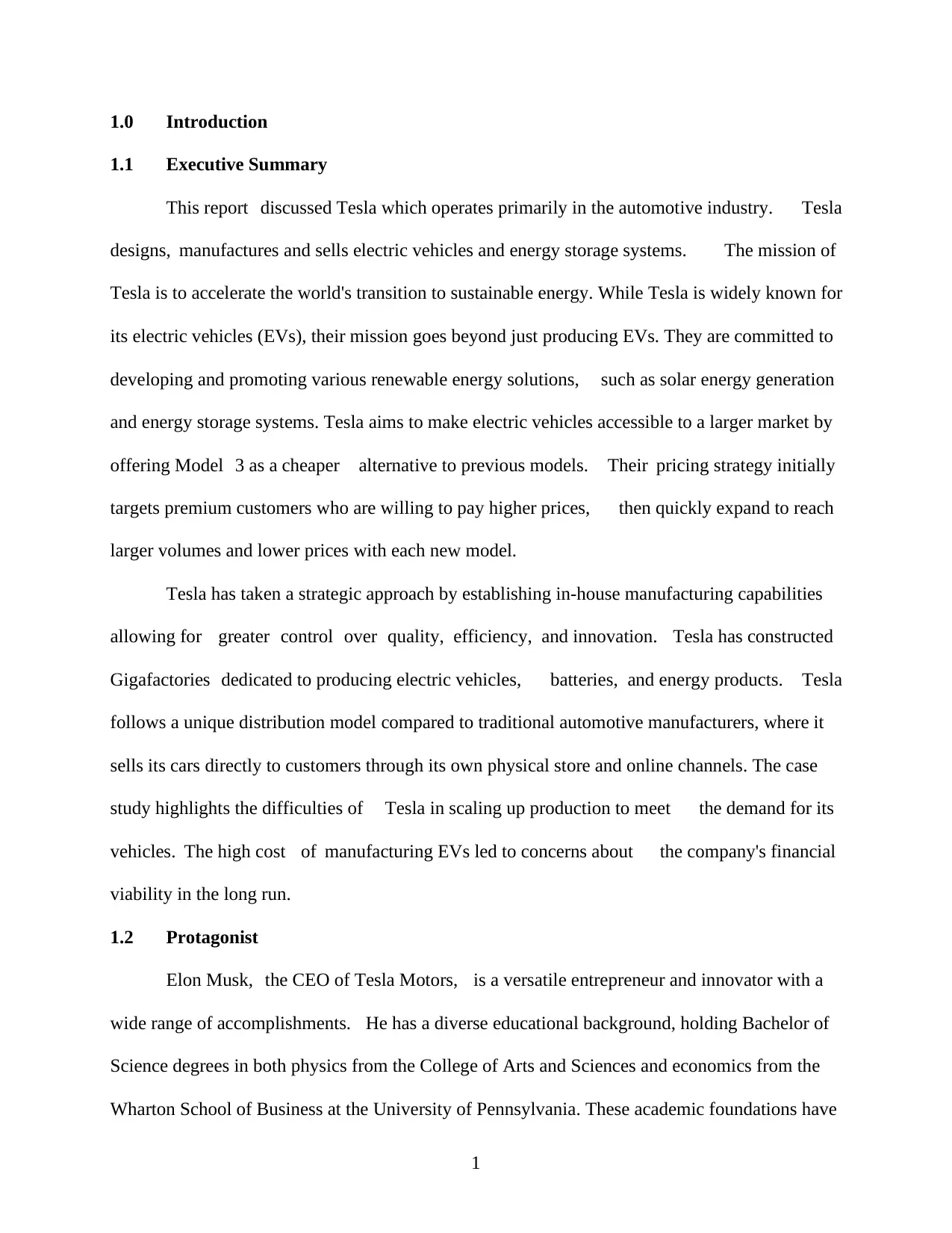
1.0 Introduction
1.1 Executive Summary
This report discussed Tesla which operates primarily in the automotive industry. Tesla
designs, manufactures and sells electric vehicles and energy storage systems. The mission of
Tesla is to accelerate the world's transition to sustainable energy. While Tesla is widely known for
its electric vehicles (EVs), their mission goes beyond just producing EVs. They are committed to
developing and promoting various renewable energy solutions, such as solar energy generation
and energy storage systems. Tesla aims to make electric vehicles accessible to a larger market by
offering Model 3 as a cheaper alternative to previous models. Their pricing strategy initially
targets premium customers who are willing to pay higher prices, then quickly expand to reach
larger volumes and lower prices with each new model.
Tesla has taken a strategic approach by establishing in-house manufacturing capabilities
allowing for greater control over quality, efficiency, and innovation. Tesla has constructed
Gigafactories dedicated to producing electric vehicles, batteries, and energy products. Tesla
follows a unique distribution model compared to traditional automotive manufacturers, where it
sells its cars directly to customers through its own physical store and online channels. The case
study highlights the difficulties of Tesla in scaling up production to meet the demand for its
vehicles. The high cost of manufacturing EVs led to concerns about the company's financial
viability in the long run.
1.2 Protagonist
Elon Musk, the CEO of Tesla Motors, is a versatile entrepreneur and innovator with a
wide range of accomplishments. He has a diverse educational background, holding Bachelor of
Science degrees in both physics from the College of Arts and Sciences and economics from the
Wharton School of Business at the University of Pennsylvania. These academic foundations have
1
1.1 Executive Summary
This report discussed Tesla which operates primarily in the automotive industry. Tesla
designs, manufactures and sells electric vehicles and energy storage systems. The mission of
Tesla is to accelerate the world's transition to sustainable energy. While Tesla is widely known for
its electric vehicles (EVs), their mission goes beyond just producing EVs. They are committed to
developing and promoting various renewable energy solutions, such as solar energy generation
and energy storage systems. Tesla aims to make electric vehicles accessible to a larger market by
offering Model 3 as a cheaper alternative to previous models. Their pricing strategy initially
targets premium customers who are willing to pay higher prices, then quickly expand to reach
larger volumes and lower prices with each new model.
Tesla has taken a strategic approach by establishing in-house manufacturing capabilities
allowing for greater control over quality, efficiency, and innovation. Tesla has constructed
Gigafactories dedicated to producing electric vehicles, batteries, and energy products. Tesla
follows a unique distribution model compared to traditional automotive manufacturers, where it
sells its cars directly to customers through its own physical store and online channels. The case
study highlights the difficulties of Tesla in scaling up production to meet the demand for its
vehicles. The high cost of manufacturing EVs led to concerns about the company's financial
viability in the long run.
1.2 Protagonist
Elon Musk, the CEO of Tesla Motors, is a versatile entrepreneur and innovator with a
wide range of accomplishments. He has a diverse educational background, holding Bachelor of
Science degrees in both physics from the College of Arts and Sciences and economics from the
Wharton School of Business at the University of Pennsylvania. These academic foundations have
1
⊘ This is a preview!⊘
Do you want full access?
Subscribe today to unlock all pages.

Trusted by 1+ million students worldwide
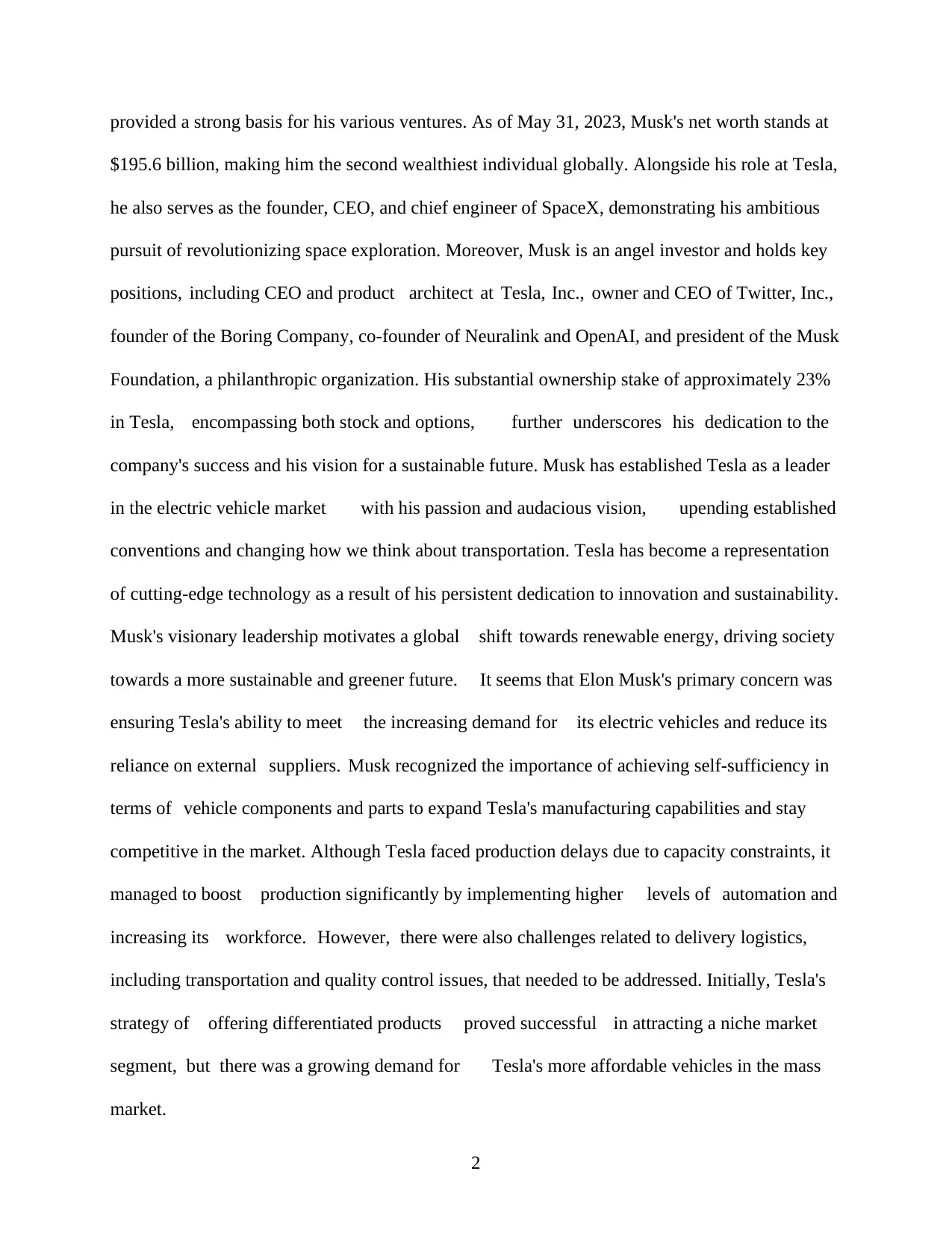
provided a strong basis for his various ventures. As of May 31, 2023, Musk's net worth stands at
$195.6 billion, making him the second wealthiest individual globally. Alongside his role at Tesla,
he also serves as the founder, CEO, and chief engineer of SpaceX, demonstrating his ambitious
pursuit of revolutionizing space exploration. Moreover, Musk is an angel investor and holds key
positions, including CEO and product architect at Tesla, Inc., owner and CEO of Twitter, Inc.,
founder of the Boring Company, co-founder of Neuralink and OpenAI, and president of the Musk
Foundation, a philanthropic organization. His substantial ownership stake of approximately 23%
in Tesla, encompassing both stock and options, further underscores his dedication to the
company's success and his vision for a sustainable future. Musk has established Tesla as a leader
in the electric vehicle market with his passion and audacious vision, upending established
conventions and changing how we think about transportation. Tesla has become a representation
of cutting-edge technology as a result of his persistent dedication to innovation and sustainability.
Musk's visionary leadership motivates a global shift towards renewable energy, driving society
towards a more sustainable and greener future. It seems that Elon Musk's primary concern was
ensuring Tesla's ability to meet the increasing demand for its electric vehicles and reduce its
reliance on external suppliers. Musk recognized the importance of achieving self-sufficiency in
terms of vehicle components and parts to expand Tesla's manufacturing capabilities and stay
competitive in the market. Although Tesla faced production delays due to capacity constraints, it
managed to boost production significantly by implementing higher levels of automation and
increasing its workforce. However, there were also challenges related to delivery logistics,
including transportation and quality control issues, that needed to be addressed. Initially, Tesla's
strategy of offering differentiated products proved successful in attracting a niche market
segment, but there was a growing demand for Tesla's more affordable vehicles in the mass
market.
2
$195.6 billion, making him the second wealthiest individual globally. Alongside his role at Tesla,
he also serves as the founder, CEO, and chief engineer of SpaceX, demonstrating his ambitious
pursuit of revolutionizing space exploration. Moreover, Musk is an angel investor and holds key
positions, including CEO and product architect at Tesla, Inc., owner and CEO of Twitter, Inc.,
founder of the Boring Company, co-founder of Neuralink and OpenAI, and president of the Musk
Foundation, a philanthropic organization. His substantial ownership stake of approximately 23%
in Tesla, encompassing both stock and options, further underscores his dedication to the
company's success and his vision for a sustainable future. Musk has established Tesla as a leader
in the electric vehicle market with his passion and audacious vision, upending established
conventions and changing how we think about transportation. Tesla has become a representation
of cutting-edge technology as a result of his persistent dedication to innovation and sustainability.
Musk's visionary leadership motivates a global shift towards renewable energy, driving society
towards a more sustainable and greener future. It seems that Elon Musk's primary concern was
ensuring Tesla's ability to meet the increasing demand for its electric vehicles and reduce its
reliance on external suppliers. Musk recognized the importance of achieving self-sufficiency in
terms of vehicle components and parts to expand Tesla's manufacturing capabilities and stay
competitive in the market. Although Tesla faced production delays due to capacity constraints, it
managed to boost production significantly by implementing higher levels of automation and
increasing its workforce. However, there were also challenges related to delivery logistics,
including transportation and quality control issues, that needed to be addressed. Initially, Tesla's
strategy of offering differentiated products proved successful in attracting a niche market
segment, but there was a growing demand for Tesla's more affordable vehicles in the mass
market.
2
Paraphrase This Document
Need a fresh take? Get an instant paraphrase of this document with our AI Paraphraser
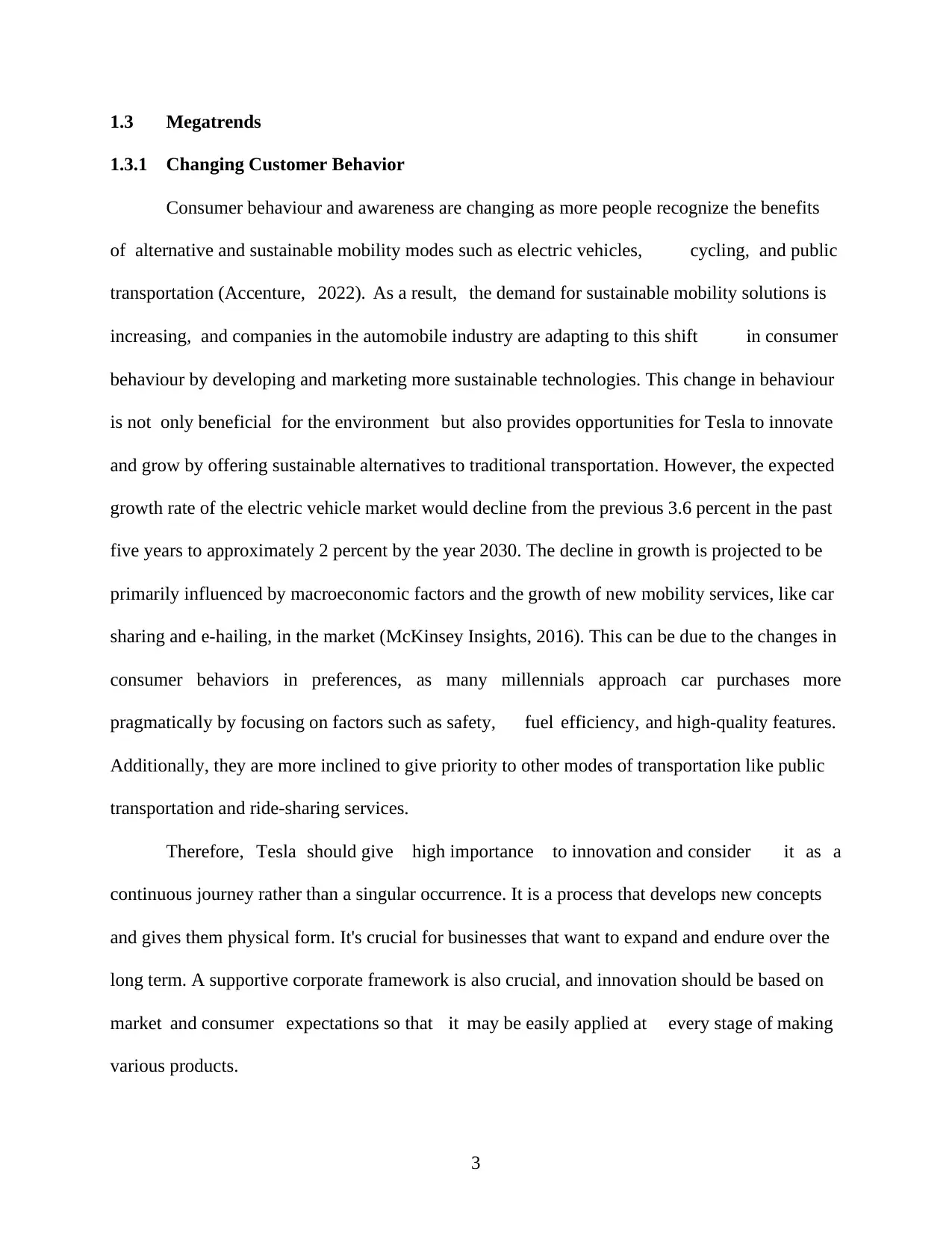
1.3 Megatrends
1.3.1 Changing Customer Behavior
Consumer behaviour and awareness are changing as more people recognize the benefits
of alternative and sustainable mobility modes such as electric vehicles, cycling, and public
transportation (Accenture, 2022). As a result, the demand for sustainable mobility solutions is
increasing, and companies in the automobile industry are adapting to this shift in consumer
behaviour by developing and marketing more sustainable technologies. This change in behaviour
is not only beneficial for the environment but also provides opportunities for Tesla to innovate
and grow by offering sustainable alternatives to traditional transportation. However, the expected
growth rate of the electric vehicle market would decline from the previous 3.6 percent in the past
five years to approximately 2 percent by the year 2030. The decline in growth is projected to be
primarily influenced by macroeconomic factors and the growth of new mobility services, like car
sharing and e-hailing, in the market (McKinsey Insights, 2016). This can be due to the changes in
consumer behaviors in preferences, as many millennials approach car purchases more
pragmatically by focusing on factors such as safety, fuel efficiency, and high-quality features.
Additionally, they are more inclined to give priority to other modes of transportation like public
transportation and ride-sharing services.
Therefore, Tesla should give high importance to innovation and consider it as a
continuous journey rather than a singular occurrence. It is a process that develops new concepts
and gives them physical form. It's crucial for businesses that want to expand and endure over the
long term. A supportive corporate framework is also crucial, and innovation should be based on
market and consumer expectations so that it may be easily applied at every stage of making
various products.
3
1.3.1 Changing Customer Behavior
Consumer behaviour and awareness are changing as more people recognize the benefits
of alternative and sustainable mobility modes such as electric vehicles, cycling, and public
transportation (Accenture, 2022). As a result, the demand for sustainable mobility solutions is
increasing, and companies in the automobile industry are adapting to this shift in consumer
behaviour by developing and marketing more sustainable technologies. This change in behaviour
is not only beneficial for the environment but also provides opportunities for Tesla to innovate
and grow by offering sustainable alternatives to traditional transportation. However, the expected
growth rate of the electric vehicle market would decline from the previous 3.6 percent in the past
five years to approximately 2 percent by the year 2030. The decline in growth is projected to be
primarily influenced by macroeconomic factors and the growth of new mobility services, like car
sharing and e-hailing, in the market (McKinsey Insights, 2016). This can be due to the changes in
consumer behaviors in preferences, as many millennials approach car purchases more
pragmatically by focusing on factors such as safety, fuel efficiency, and high-quality features.
Additionally, they are more inclined to give priority to other modes of transportation like public
transportation and ride-sharing services.
Therefore, Tesla should give high importance to innovation and consider it as a
continuous journey rather than a singular occurrence. It is a process that develops new concepts
and gives them physical form. It's crucial for businesses that want to expand and endure over the
long term. A supportive corporate framework is also crucial, and innovation should be based on
market and consumer expectations so that it may be easily applied at every stage of making
various products.
3
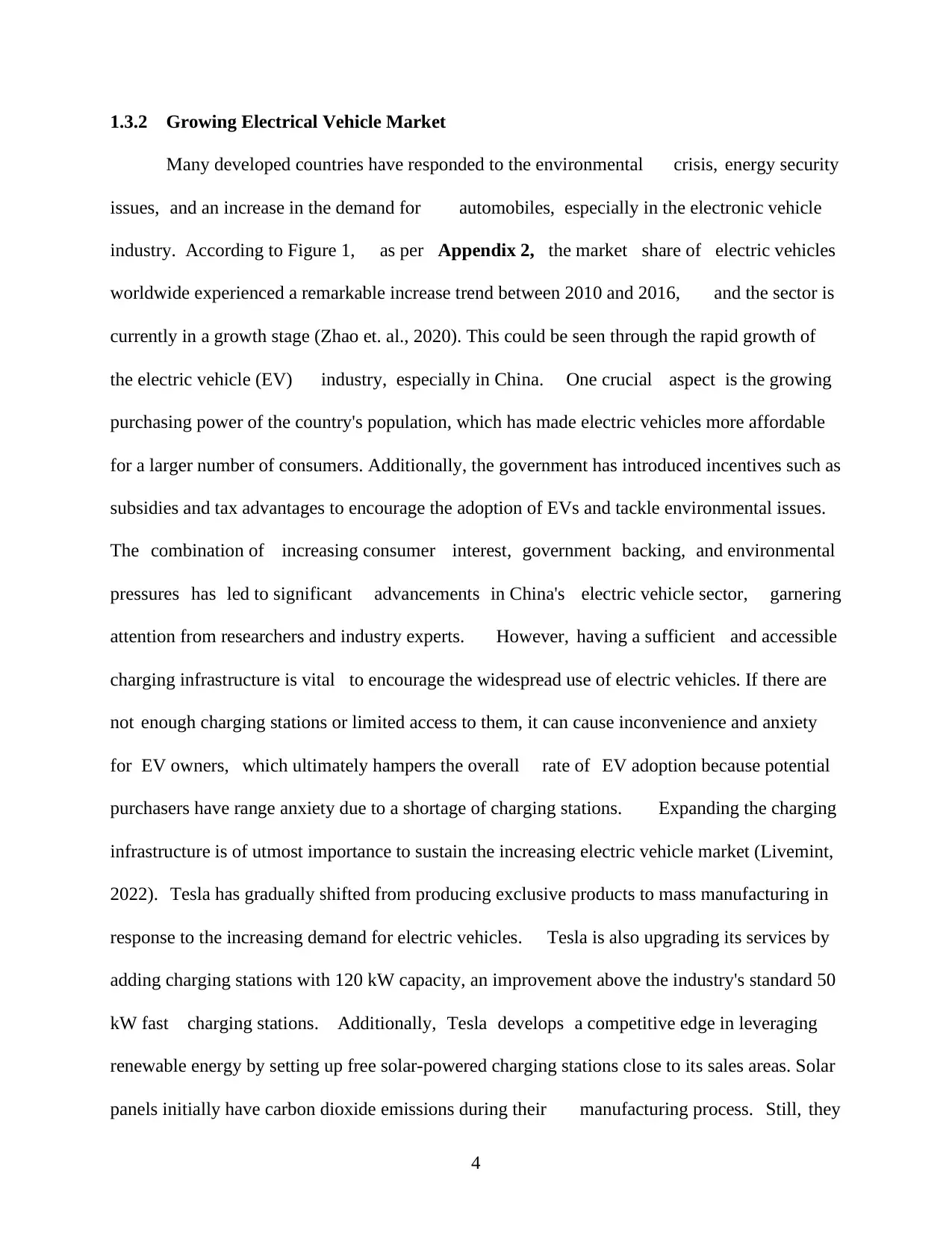
1.3.2 Growing Electrical Vehicle Market
Many developed countries have responded to the environmental crisis, energy security
issues, and an increase in the demand for automobiles, especially in the electronic vehicle
industry. According to Figure 1, as per Appendix 2, the market share of electric vehicles
worldwide experienced a remarkable increase trend between 2010 and 2016, and the sector is
currently in a growth stage (Zhao et. al., 2020). This could be seen through the rapid growth of
the electric vehicle (EV) industry, especially in China. One crucial aspect is the growing
purchasing power of the country's population, which has made electric vehicles more affordable
for a larger number of consumers. Additionally, the government has introduced incentives such as
subsidies and tax advantages to encourage the adoption of EVs and tackle environmental issues.
The combination of increasing consumer interest, government backing, and environmental
pressures has led to significant advancements in China's electric vehicle sector, garnering
attention from researchers and industry experts. However, having a sufficient and accessible
charging infrastructure is vital to encourage the widespread use of electric vehicles. If there are
not enough charging stations or limited access to them, it can cause inconvenience and anxiety
for EV owners, which ultimately hampers the overall rate of EV adoption because potential
purchasers have range anxiety due to a shortage of charging stations. Expanding the charging
infrastructure is of utmost importance to sustain the increasing electric vehicle market (Livemint,
2022). Tesla has gradually shifted from producing exclusive products to mass manufacturing in
response to the increasing demand for electric vehicles. Tesla is also upgrading its services by
adding charging stations with 120 kW capacity, an improvement above the industry's standard 50
kW fast charging stations. Additionally, Tesla develops a competitive edge in leveraging
renewable energy by setting up free solar-powered charging stations close to its sales areas. Solar
panels initially have carbon dioxide emissions during their manufacturing process. Still, they
4
Many developed countries have responded to the environmental crisis, energy security
issues, and an increase in the demand for automobiles, especially in the electronic vehicle
industry. According to Figure 1, as per Appendix 2, the market share of electric vehicles
worldwide experienced a remarkable increase trend between 2010 and 2016, and the sector is
currently in a growth stage (Zhao et. al., 2020). This could be seen through the rapid growth of
the electric vehicle (EV) industry, especially in China. One crucial aspect is the growing
purchasing power of the country's population, which has made electric vehicles more affordable
for a larger number of consumers. Additionally, the government has introduced incentives such as
subsidies and tax advantages to encourage the adoption of EVs and tackle environmental issues.
The combination of increasing consumer interest, government backing, and environmental
pressures has led to significant advancements in China's electric vehicle sector, garnering
attention from researchers and industry experts. However, having a sufficient and accessible
charging infrastructure is vital to encourage the widespread use of electric vehicles. If there are
not enough charging stations or limited access to them, it can cause inconvenience and anxiety
for EV owners, which ultimately hampers the overall rate of EV adoption because potential
purchasers have range anxiety due to a shortage of charging stations. Expanding the charging
infrastructure is of utmost importance to sustain the increasing electric vehicle market (Livemint,
2022). Tesla has gradually shifted from producing exclusive products to mass manufacturing in
response to the increasing demand for electric vehicles. Tesla is also upgrading its services by
adding charging stations with 120 kW capacity, an improvement above the industry's standard 50
kW fast charging stations. Additionally, Tesla develops a competitive edge in leveraging
renewable energy by setting up free solar-powered charging stations close to its sales areas. Solar
panels initially have carbon dioxide emissions during their manufacturing process. Still, they
4
⊘ This is a preview!⊘
Do you want full access?
Subscribe today to unlock all pages.

Trusted by 1+ million students worldwide
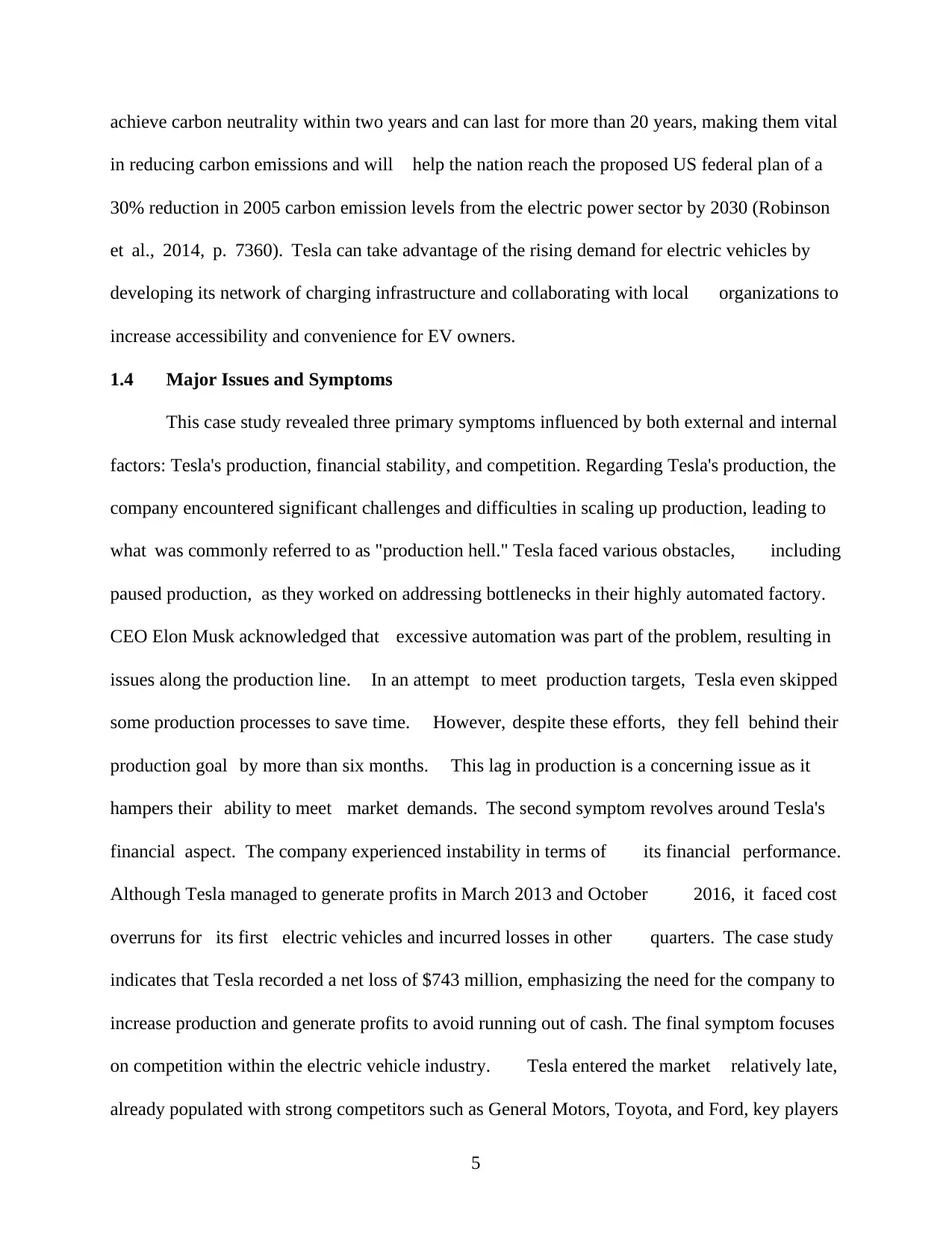
achieve carbon neutrality within two years and can last for more than 20 years, making them vital
in reducing carbon emissions and will help the nation reach the proposed US federal plan of a
30% reduction in 2005 carbon emission levels from the electric power sector by 2030 (Robinson
et al., 2014, p. 7360). Tesla can take advantage of the rising demand for electric vehicles by
developing its network of charging infrastructure and collaborating with local organizations to
increase accessibility and convenience for EV owners.
1.4 Major Issues and Symptoms
This case study revealed three primary symptoms influenced by both external and internal
factors: Tesla's production, financial stability, and competition. Regarding Tesla's production, the
company encountered significant challenges and difficulties in scaling up production, leading to
what was commonly referred to as "production hell." Tesla faced various obstacles, including
paused production, as they worked on addressing bottlenecks in their highly automated factory.
CEO Elon Musk acknowledged that excessive automation was part of the problem, resulting in
issues along the production line. In an attempt to meet production targets, Tesla even skipped
some production processes to save time. However, despite these efforts, they fell behind their
production goal by more than six months. This lag in production is a concerning issue as it
hampers their ability to meet market demands. The second symptom revolves around Tesla's
financial aspect. The company experienced instability in terms of its financial performance.
Although Tesla managed to generate profits in March 2013 and October 2016, it faced cost
overruns for its first electric vehicles and incurred losses in other quarters. The case study
indicates that Tesla recorded a net loss of $743 million, emphasizing the need for the company to
increase production and generate profits to avoid running out of cash. The final symptom focuses
on competition within the electric vehicle industry. Tesla entered the market relatively late,
already populated with strong competitors such as General Motors, Toyota, and Ford, key players
5
in reducing carbon emissions and will help the nation reach the proposed US federal plan of a
30% reduction in 2005 carbon emission levels from the electric power sector by 2030 (Robinson
et al., 2014, p. 7360). Tesla can take advantage of the rising demand for electric vehicles by
developing its network of charging infrastructure and collaborating with local organizations to
increase accessibility and convenience for EV owners.
1.4 Major Issues and Symptoms
This case study revealed three primary symptoms influenced by both external and internal
factors: Tesla's production, financial stability, and competition. Regarding Tesla's production, the
company encountered significant challenges and difficulties in scaling up production, leading to
what was commonly referred to as "production hell." Tesla faced various obstacles, including
paused production, as they worked on addressing bottlenecks in their highly automated factory.
CEO Elon Musk acknowledged that excessive automation was part of the problem, resulting in
issues along the production line. In an attempt to meet production targets, Tesla even skipped
some production processes to save time. However, despite these efforts, they fell behind their
production goal by more than six months. This lag in production is a concerning issue as it
hampers their ability to meet market demands. The second symptom revolves around Tesla's
financial aspect. The company experienced instability in terms of its financial performance.
Although Tesla managed to generate profits in March 2013 and October 2016, it faced cost
overruns for its first electric vehicles and incurred losses in other quarters. The case study
indicates that Tesla recorded a net loss of $743 million, emphasizing the need for the company to
increase production and generate profits to avoid running out of cash. The final symptom focuses
on competition within the electric vehicle industry. Tesla entered the market relatively late,
already populated with strong competitors such as General Motors, Toyota, and Ford, key players
5
Paraphrase This Document
Need a fresh take? Get an instant paraphrase of this document with our AI Paraphraser
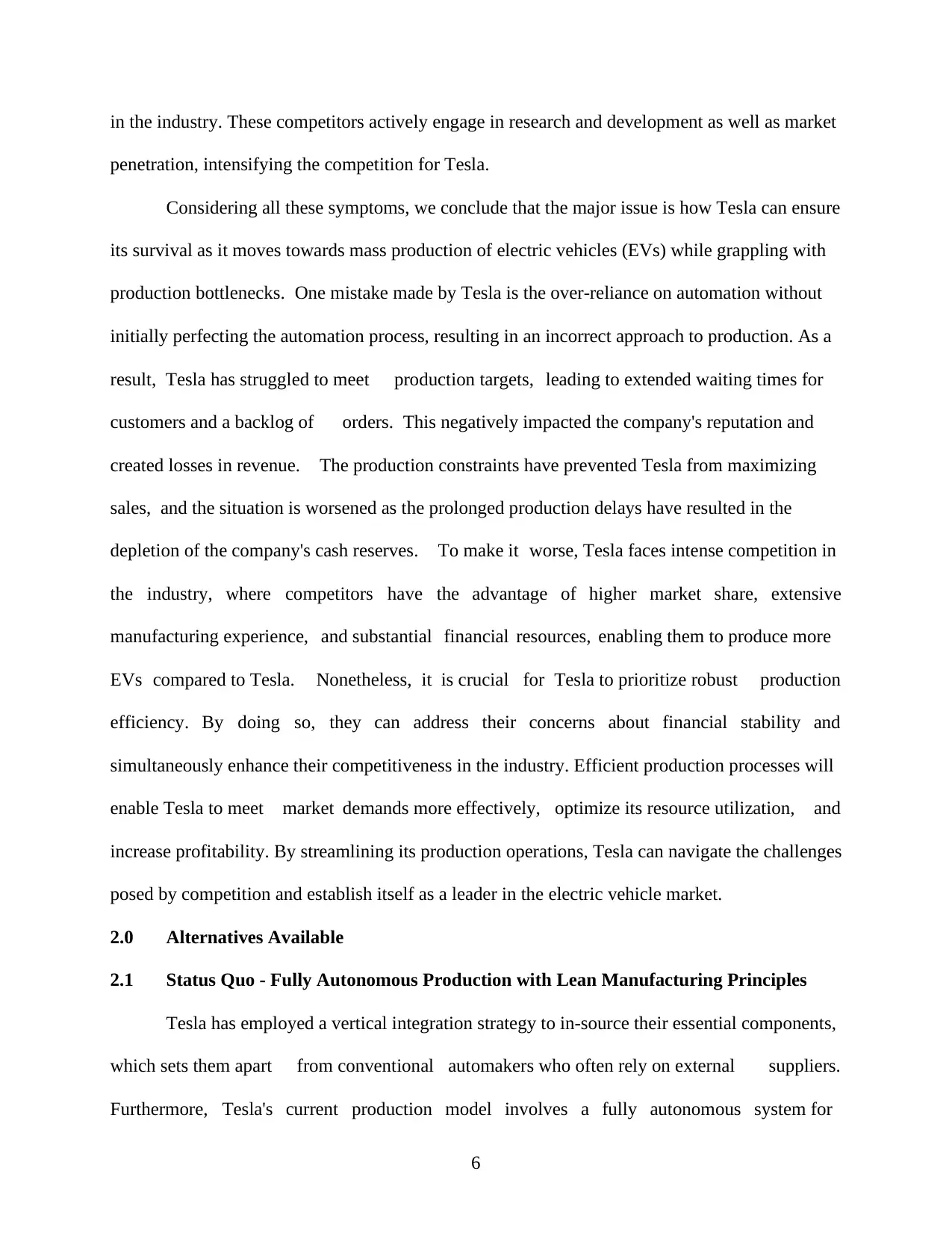
in the industry. These competitors actively engage in research and development as well as market
penetration, intensifying the competition for Tesla.
Considering all these symptoms, we conclude that the major issue is how Tesla can ensure
its survival as it moves towards mass production of electric vehicles (EVs) while grappling with
production bottlenecks. One mistake made by Tesla is the over-reliance on automation without
initially perfecting the automation process, resulting in an incorrect approach to production. As a
result, Tesla has struggled to meet production targets, leading to extended waiting times for
customers and a backlog of orders. This negatively impacted the company's reputation and
created losses in revenue. The production constraints have prevented Tesla from maximizing
sales, and the situation is worsened as the prolonged production delays have resulted in the
depletion of the company's cash reserves. To make it worse, Tesla faces intense competition in
the industry, where competitors have the advantage of higher market share, extensive
manufacturing experience, and substantial financial resources, enabling them to produce more
EVs compared to Tesla. Nonetheless, it is crucial for Tesla to prioritize robust production
efficiency. By doing so, they can address their concerns about financial stability and
simultaneously enhance their competitiveness in the industry. Efficient production processes will
enable Tesla to meet market demands more effectively, optimize its resource utilization, and
increase profitability. By streamlining its production operations, Tesla can navigate the challenges
posed by competition and establish itself as a leader in the electric vehicle market.
2.0 Alternatives Available
2.1 Status Quo - Fully Autonomous Production with Lean Manufacturing Principles
Tesla has employed a vertical integration strategy to in-source their essential components,
which sets them apart from conventional automakers who often rely on external suppliers.
Furthermore, Tesla's current production model involves a fully autonomous system for
6
penetration, intensifying the competition for Tesla.
Considering all these symptoms, we conclude that the major issue is how Tesla can ensure
its survival as it moves towards mass production of electric vehicles (EVs) while grappling with
production bottlenecks. One mistake made by Tesla is the over-reliance on automation without
initially perfecting the automation process, resulting in an incorrect approach to production. As a
result, Tesla has struggled to meet production targets, leading to extended waiting times for
customers and a backlog of orders. This negatively impacted the company's reputation and
created losses in revenue. The production constraints have prevented Tesla from maximizing
sales, and the situation is worsened as the prolonged production delays have resulted in the
depletion of the company's cash reserves. To make it worse, Tesla faces intense competition in
the industry, where competitors have the advantage of higher market share, extensive
manufacturing experience, and substantial financial resources, enabling them to produce more
EVs compared to Tesla. Nonetheless, it is crucial for Tesla to prioritize robust production
efficiency. By doing so, they can address their concerns about financial stability and
simultaneously enhance their competitiveness in the industry. Efficient production processes will
enable Tesla to meet market demands more effectively, optimize its resource utilization, and
increase profitability. By streamlining its production operations, Tesla can navigate the challenges
posed by competition and establish itself as a leader in the electric vehicle market.
2.0 Alternatives Available
2.1 Status Quo - Fully Autonomous Production with Lean Manufacturing Principles
Tesla has employed a vertical integration strategy to in-source their essential components,
which sets them apart from conventional automakers who often rely on external suppliers.
Furthermore, Tesla's current production model involves a fully autonomous system for
6
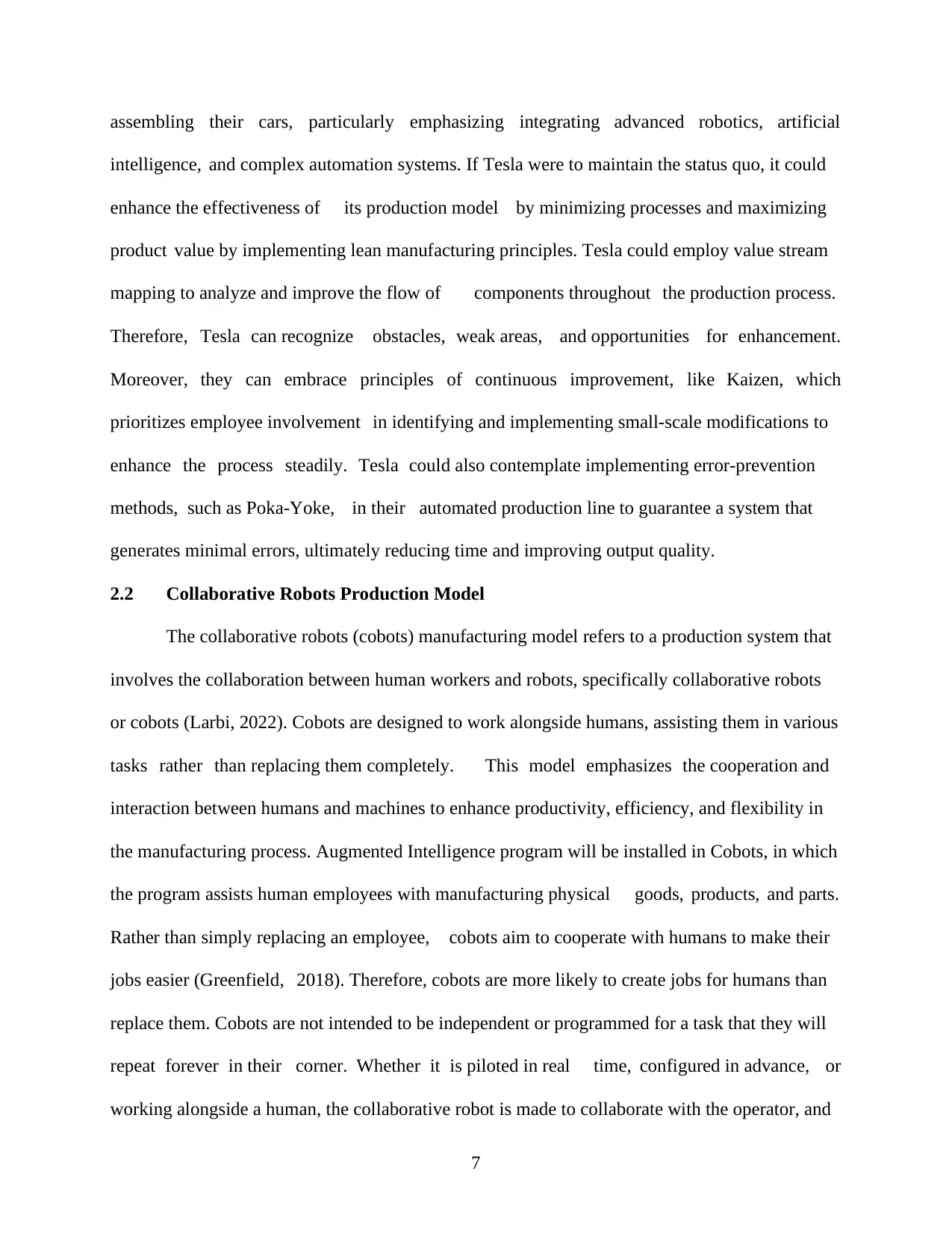
assembling their cars, particularly emphasizing integrating advanced robotics, artificial
intelligence, and complex automation systems. If Tesla were to maintain the status quo, it could
enhance the effectiveness of its production model by minimizing processes and maximizing
product value by implementing lean manufacturing principles. Tesla could employ value stream
mapping to analyze and improve the flow of components throughout the production process.
Therefore, Tesla can recognize obstacles, weak areas, and opportunities for enhancement.
Moreover, they can embrace principles of continuous improvement, like Kaizen, which
prioritizes employee involvement in identifying and implementing small-scale modifications to
enhance the process steadily. Tesla could also contemplate implementing error-prevention
methods, such as Poka-Yoke, in their automated production line to guarantee a system that
generates minimal errors, ultimately reducing time and improving output quality.
2.2 Collaborative Robots Production Model
The collaborative robots (cobots) manufacturing model refers to a production system that
involves the collaboration between human workers and robots, specifically collaborative robots
or cobots (Larbi, 2022). Cobots are designed to work alongside humans, assisting them in various
tasks rather than replacing them completely. This model emphasizes the cooperation and
interaction between humans and machines to enhance productivity, efficiency, and flexibility in
the manufacturing process. Augmented Intelligence program will be installed in Cobots, in which
the program assists human employees with manufacturing physical goods, products, and parts.
Rather than simply replacing an employee, cobots aim to cooperate with humans to make their
jobs easier (Greenfield, 2018). Therefore, cobots are more likely to create jobs for humans than
replace them. Cobots are not intended to be independent or programmed for a task that they will
repeat forever in their corner. Whether it is piloted in real time, configured in advance, or
working alongside a human, the collaborative robot is made to collaborate with the operator, and
7
intelligence, and complex automation systems. If Tesla were to maintain the status quo, it could
enhance the effectiveness of its production model by minimizing processes and maximizing
product value by implementing lean manufacturing principles. Tesla could employ value stream
mapping to analyze and improve the flow of components throughout the production process.
Therefore, Tesla can recognize obstacles, weak areas, and opportunities for enhancement.
Moreover, they can embrace principles of continuous improvement, like Kaizen, which
prioritizes employee involvement in identifying and implementing small-scale modifications to
enhance the process steadily. Tesla could also contemplate implementing error-prevention
methods, such as Poka-Yoke, in their automated production line to guarantee a system that
generates minimal errors, ultimately reducing time and improving output quality.
2.2 Collaborative Robots Production Model
The collaborative robots (cobots) manufacturing model refers to a production system that
involves the collaboration between human workers and robots, specifically collaborative robots
or cobots (Larbi, 2022). Cobots are designed to work alongside humans, assisting them in various
tasks rather than replacing them completely. This model emphasizes the cooperation and
interaction between humans and machines to enhance productivity, efficiency, and flexibility in
the manufacturing process. Augmented Intelligence program will be installed in Cobots, in which
the program assists human employees with manufacturing physical goods, products, and parts.
Rather than simply replacing an employee, cobots aim to cooperate with humans to make their
jobs easier (Greenfield, 2018). Therefore, cobots are more likely to create jobs for humans than
replace them. Cobots are not intended to be independent or programmed for a task that they will
repeat forever in their corner. Whether it is piloted in real time, configured in advance, or
working alongside a human, the collaborative robot is made to collaborate with the operator, and
7
⊘ This is a preview!⊘
Do you want full access?
Subscribe today to unlock all pages.

Trusted by 1+ million students worldwide
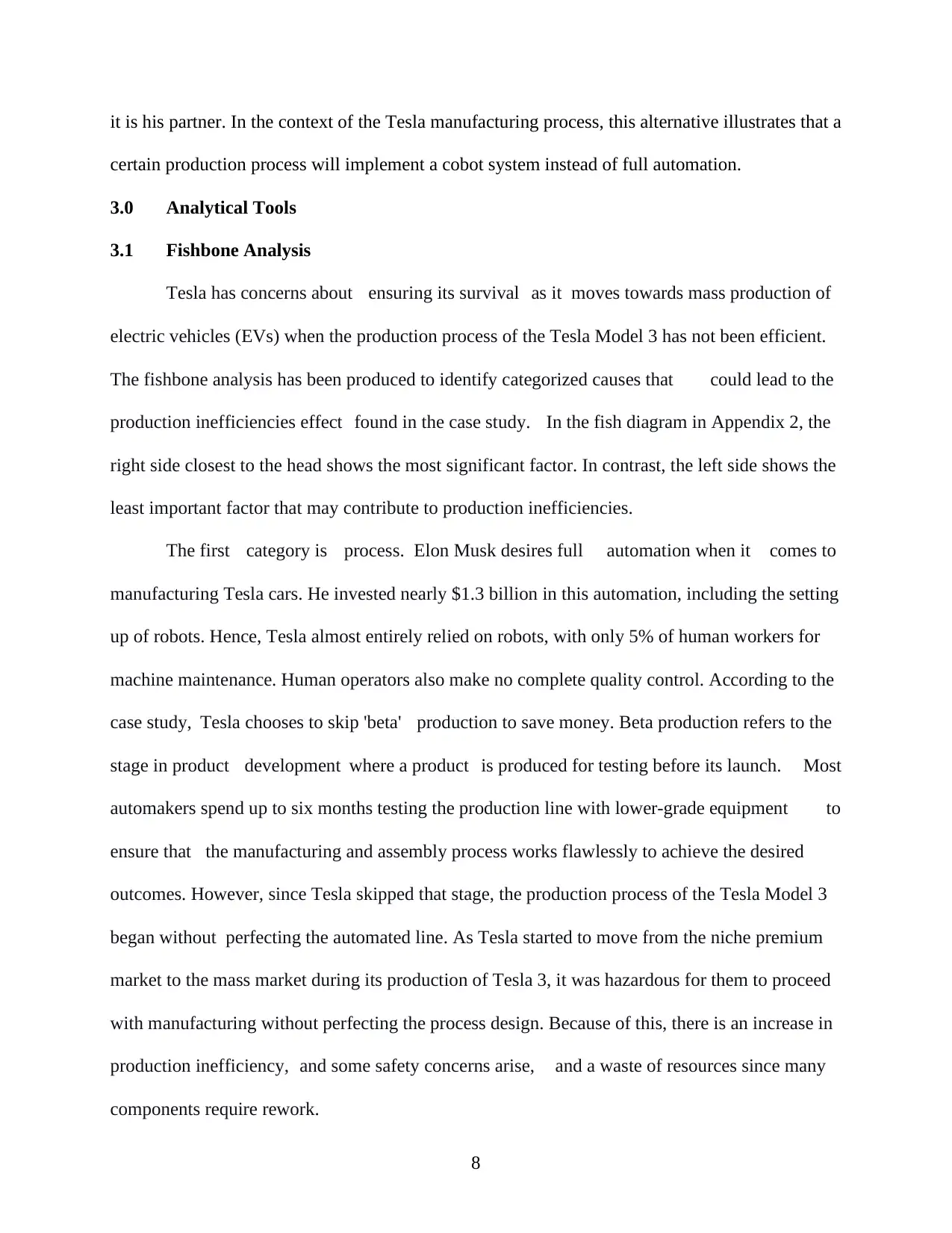
it is his partner. In the context of the Tesla manufacturing process, this alternative illustrates that a
certain production process will implement a cobot system instead of full automation.
3.0 Analytical Tools
3.1 Fishbone Analysis
Tesla has concerns about ensuring its survival as it moves towards mass production of
electric vehicles (EVs) when the production process of the Tesla Model 3 has not been efficient.
The fishbone analysis has been produced to identify categorized causes that could lead to the
production inefficiencies effect found in the case study. In the fish diagram in Appendix 2, the
right side closest to the head shows the most significant factor. In contrast, the left side shows the
least important factor that may contribute to production inefficiencies.
The first category is process. Elon Musk desires full automation when it comes to
manufacturing Tesla cars. He invested nearly $1.3 billion in this automation, including the setting
up of robots. Hence, Tesla almost entirely relied on robots, with only 5% of human workers for
machine maintenance. Human operators also make no complete quality control. According to the
case study, Tesla chooses to skip 'beta' production to save money. Beta production refers to the
stage in product development where a product is produced for testing before its launch. Most
automakers spend up to six months testing the production line with lower-grade equipment to
ensure that the manufacturing and assembly process works flawlessly to achieve the desired
outcomes. However, since Tesla skipped that stage, the production process of the Tesla Model 3
began without perfecting the automated line. As Tesla started to move from the niche premium
market to the mass market during its production of Tesla 3, it was hazardous for them to proceed
with manufacturing without perfecting the process design. Because of this, there is an increase in
production inefficiency, and some safety concerns arise, and a waste of resources since many
components require rework.
8
certain production process will implement a cobot system instead of full automation.
3.0 Analytical Tools
3.1 Fishbone Analysis
Tesla has concerns about ensuring its survival as it moves towards mass production of
electric vehicles (EVs) when the production process of the Tesla Model 3 has not been efficient.
The fishbone analysis has been produced to identify categorized causes that could lead to the
production inefficiencies effect found in the case study. In the fish diagram in Appendix 2, the
right side closest to the head shows the most significant factor. In contrast, the left side shows the
least important factor that may contribute to production inefficiencies.
The first category is process. Elon Musk desires full automation when it comes to
manufacturing Tesla cars. He invested nearly $1.3 billion in this automation, including the setting
up of robots. Hence, Tesla almost entirely relied on robots, with only 5% of human workers for
machine maintenance. Human operators also make no complete quality control. According to the
case study, Tesla chooses to skip 'beta' production to save money. Beta production refers to the
stage in product development where a product is produced for testing before its launch. Most
automakers spend up to six months testing the production line with lower-grade equipment to
ensure that the manufacturing and assembly process works flawlessly to achieve the desired
outcomes. However, since Tesla skipped that stage, the production process of the Tesla Model 3
began without perfecting the automated line. As Tesla started to move from the niche premium
market to the mass market during its production of Tesla 3, it was hazardous for them to proceed
with manufacturing without perfecting the process design. Because of this, there is an increase in
production inefficiency, and some safety concerns arise, and a waste of resources since many
components require rework.
8
Paraphrase This Document
Need a fresh take? Get an instant paraphrase of this document with our AI Paraphraser
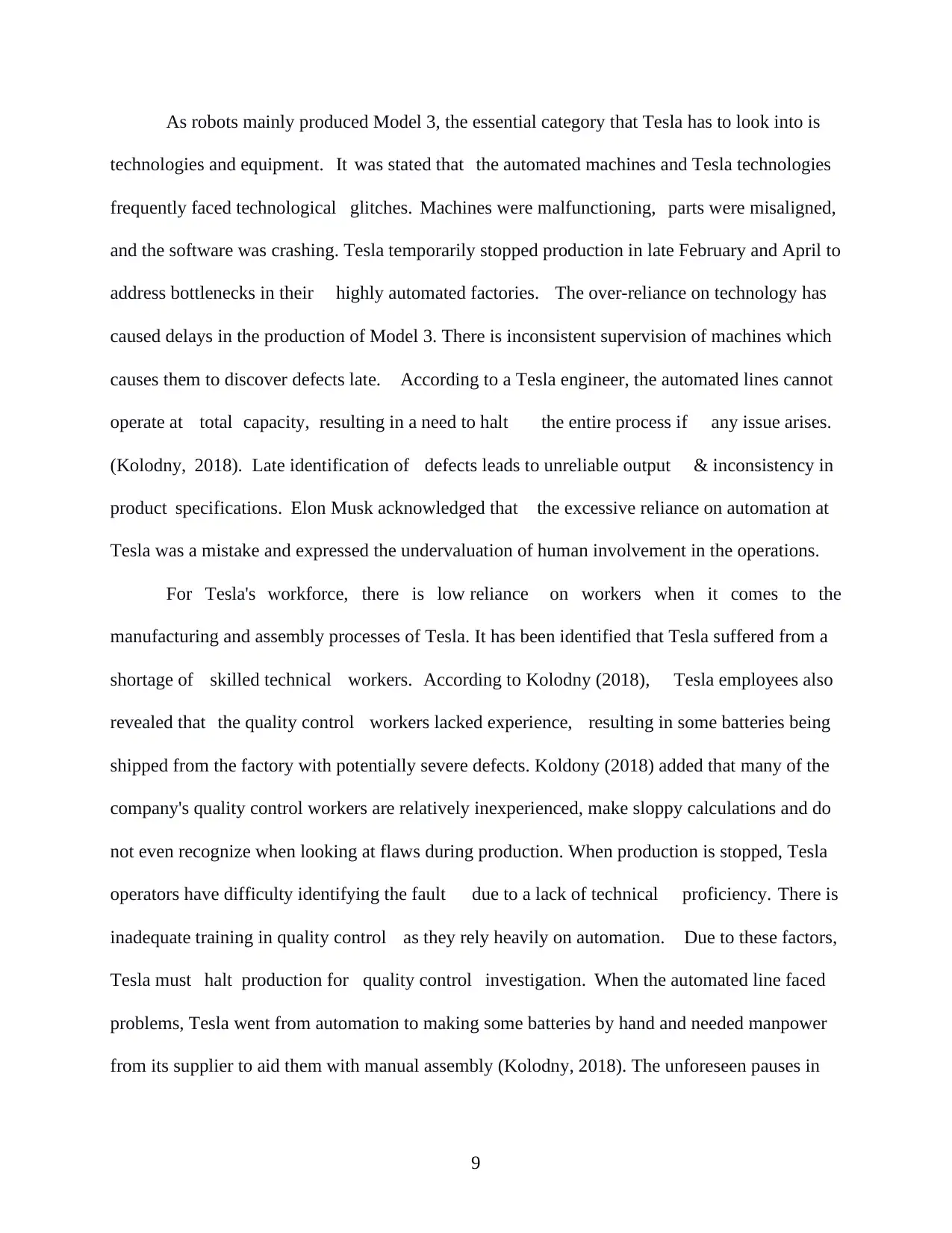
As robots mainly produced Model 3, the essential category that Tesla has to look into is
technologies and equipment. It was stated that the automated machines and Tesla technologies
frequently faced technological glitches. Machines were malfunctioning, parts were misaligned,
and the software was crashing. Tesla temporarily stopped production in late February and April to
address bottlenecks in their highly automated factories. The over-reliance on technology has
caused delays in the production of Model 3. There is inconsistent supervision of machines which
causes them to discover defects late. According to a Tesla engineer, the automated lines cannot
operate at total capacity, resulting in a need to halt the entire process if any issue arises.
(Kolodny, 2018). Late identification of defects leads to unreliable output & inconsistency in
product specifications. Elon Musk acknowledged that the excessive reliance on automation at
Tesla was a mistake and expressed the undervaluation of human involvement in the operations.
For Tesla's workforce, there is low reliance on workers when it comes to the
manufacturing and assembly processes of Tesla. It has been identified that Tesla suffered from a
shortage of skilled technical workers. According to Kolodny (2018), Tesla employees also
revealed that the quality control workers lacked experience, resulting in some batteries being
shipped from the factory with potentially severe defects. Koldony (2018) added that many of the
company's quality control workers are relatively inexperienced, make sloppy calculations and do
not even recognize when looking at flaws during production. When production is stopped, Tesla
operators have difficulty identifying the fault due to a lack of technical proficiency. There is
inadequate training in quality control as they rely heavily on automation. Due to these factors,
Tesla must halt production for quality control investigation. When the automated line faced
problems, Tesla went from automation to making some batteries by hand and needed manpower
from its supplier to aid them with manual assembly (Kolodny, 2018). The unforeseen pauses in
9
technologies and equipment. It was stated that the automated machines and Tesla technologies
frequently faced technological glitches. Machines were malfunctioning, parts were misaligned,
and the software was crashing. Tesla temporarily stopped production in late February and April to
address bottlenecks in their highly automated factories. The over-reliance on technology has
caused delays in the production of Model 3. There is inconsistent supervision of machines which
causes them to discover defects late. According to a Tesla engineer, the automated lines cannot
operate at total capacity, resulting in a need to halt the entire process if any issue arises.
(Kolodny, 2018). Late identification of defects leads to unreliable output & inconsistency in
product specifications. Elon Musk acknowledged that the excessive reliance on automation at
Tesla was a mistake and expressed the undervaluation of human involvement in the operations.
For Tesla's workforce, there is low reliance on workers when it comes to the
manufacturing and assembly processes of Tesla. It has been identified that Tesla suffered from a
shortage of skilled technical workers. According to Kolodny (2018), Tesla employees also
revealed that the quality control workers lacked experience, resulting in some batteries being
shipped from the factory with potentially severe defects. Koldony (2018) added that many of the
company's quality control workers are relatively inexperienced, make sloppy calculations and do
not even recognize when looking at flaws during production. When production is stopped, Tesla
operators have difficulty identifying the fault due to a lack of technical proficiency. There is
inadequate training in quality control as they rely heavily on automation. Due to these factors,
Tesla must halt production for quality control investigation. When the automated line faced
problems, Tesla went from automation to making some batteries by hand and needed manpower
from its supplier to aid them with manual assembly (Kolodny, 2018). The unforeseen pauses in
9
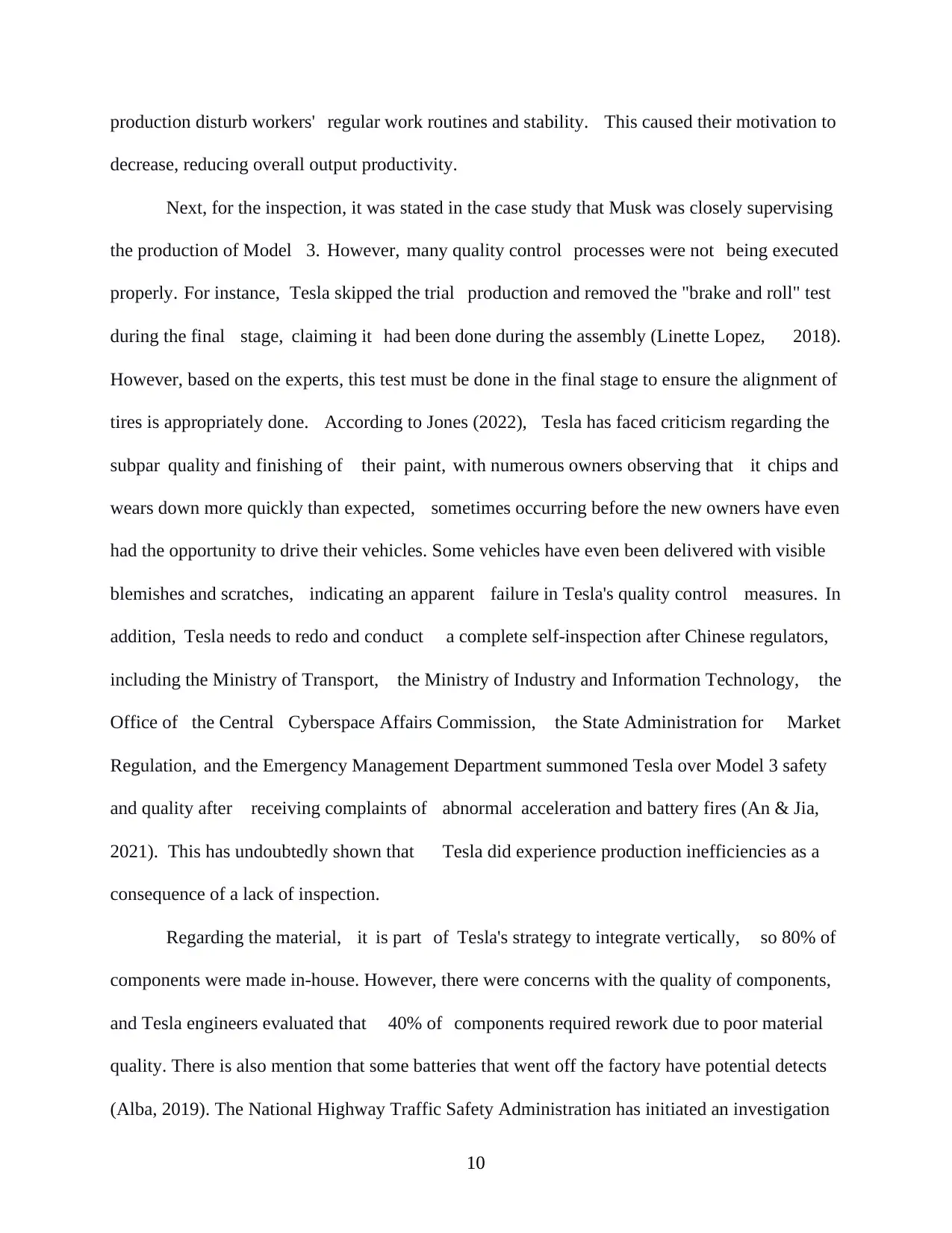
production disturb workers' regular work routines and stability. This caused their motivation to
decrease, reducing overall output productivity.
Next, for the inspection, it was stated in the case study that Musk was closely supervising
the production of Model 3. However, many quality control processes were not being executed
properly. For instance, Tesla skipped the trial production and removed the "brake and roll" test
during the final stage, claiming it had been done during the assembly (Linette Lopez, 2018).
However, based on the experts, this test must be done in the final stage to ensure the alignment of
tires is appropriately done. According to Jones (2022), Tesla has faced criticism regarding the
subpar quality and finishing of their paint, with numerous owners observing that it chips and
wears down more quickly than expected, sometimes occurring before the new owners have even
had the opportunity to drive their vehicles. Some vehicles have even been delivered with visible
blemishes and scratches, indicating an apparent failure in Tesla's quality control measures. In
addition, Tesla needs to redo and conduct a complete self-inspection after Chinese regulators,
including the Ministry of Transport, the Ministry of Industry and Information Technology, the
Office of the Central Cyberspace Affairs Commission, the State Administration for Market
Regulation, and the Emergency Management Department summoned Tesla over Model 3 safety
and quality after receiving complaints of abnormal acceleration and battery fires (An & Jia,
2021). This has undoubtedly shown that Tesla did experience production inefficiencies as a
consequence of a lack of inspection.
Regarding the material, it is part of Tesla's strategy to integrate vertically, so 80% of
components were made in-house. However, there were concerns with the quality of components,
and Tesla engineers evaluated that 40% of components required rework due to poor material
quality. There is also mention that some batteries that went off the factory have potential detects
(Alba, 2019). The National Highway Traffic Safety Administration has initiated an investigation
10
decrease, reducing overall output productivity.
Next, for the inspection, it was stated in the case study that Musk was closely supervising
the production of Model 3. However, many quality control processes were not being executed
properly. For instance, Tesla skipped the trial production and removed the "brake and roll" test
during the final stage, claiming it had been done during the assembly (Linette Lopez, 2018).
However, based on the experts, this test must be done in the final stage to ensure the alignment of
tires is appropriately done. According to Jones (2022), Tesla has faced criticism regarding the
subpar quality and finishing of their paint, with numerous owners observing that it chips and
wears down more quickly than expected, sometimes occurring before the new owners have even
had the opportunity to drive their vehicles. Some vehicles have even been delivered with visible
blemishes and scratches, indicating an apparent failure in Tesla's quality control measures. In
addition, Tesla needs to redo and conduct a complete self-inspection after Chinese regulators,
including the Ministry of Transport, the Ministry of Industry and Information Technology, the
Office of the Central Cyberspace Affairs Commission, the State Administration for Market
Regulation, and the Emergency Management Department summoned Tesla over Model 3 safety
and quality after receiving complaints of abnormal acceleration and battery fires (An & Jia,
2021). This has undoubtedly shown that Tesla did experience production inefficiencies as a
consequence of a lack of inspection.
Regarding the material, it is part of Tesla's strategy to integrate vertically, so 80% of
components were made in-house. However, there were concerns with the quality of components,
and Tesla engineers evaluated that 40% of components required rework due to poor material
quality. There is also mention that some batteries that went off the factory have potential detects
(Alba, 2019). The National Highway Traffic Safety Administration has initiated an investigation
10
⊘ This is a preview!⊘
Do you want full access?
Subscribe today to unlock all pages.

Trusted by 1+ million students worldwide
1 out of 34
Related Documents
Your All-in-One AI-Powered Toolkit for Academic Success.
+13062052269
info@desklib.com
Available 24*7 on WhatsApp / Email
![[object Object]](/_next/static/media/star-bottom.7253800d.svg)
Unlock your academic potential
Copyright © 2020–2025 A2Z Services. All Rights Reserved. Developed and managed by ZUCOL.





